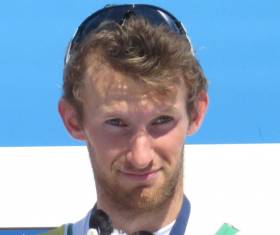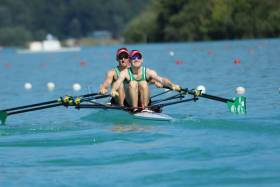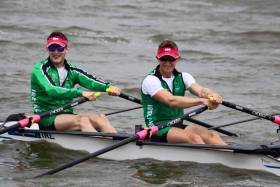Displaying items by tag: Gary O'Donovan
Ireland Team Leave for World Rowing Championships
#Rowing: The Ireland team set off for the World Rowing Championships in Florida today. Gary O’Donovan accompanied the team, and was in good form despite having to pull out of competition due to a viral infection which has limited his training. He travels as reserve. The World Championships will start in Sarasota-Bradenton on Sunday (September 24th) and continue until Ocotber 1st.
Gary O'Donovan Out of World Championships
#Rowing: The Ireland team for the World Rowing Championships has been weakened by the non-availability of Gary O’Donovan through illness. The Skibbereen man formed the lightweight double with his brother Paul which took silver at the Olympic Games in 2016. Their 2017 campaign brought them silver at the European Championships and silver and bronze in World Cup regattas. Paul O’Donovan will now defend his World Championship title in the lightweight single sculls at this year’s regatta, which begins on September 24th in Sarasota-Bradenton in Florida.
Gary O’Donovan will travel to the Championships as a spare.
Ireland Team for World Rowing Championships, Sarasota-Bradenton, Florida, September 24th-October 1st:
Men
Pair: F McQuillan-Tolan, P Boomer. Lightweight Pair: M O’Donovan, S O’Driscoll. Lightweight Single Sculls: P O’Donovan
Women
Pair: A Crowley, A Keogh. Single Sculls: S Puspure. Lightweight Single Sculls: D Walsh.
Bronze for O'Donovans at World Cup Rowing in Lucerne
#Rowing: Ireland’s Paul and Gary O’Donovan took bronze at the World Cup Regatta in Lucerne today. Olympic champions France, as has been the pattern this season, took the lead early and never relinquished it. Italy chased them all the way and took silver.
The Ireland lightweight double was in touch from early on and established themselves firmly in third coming to the line, ahead of Belgium and Greece.
World Cup Regatta, Lucerne, Day Three (Irish interest)
Men
Lightweight Double Sculls – A Final: 1 France 6:12.96, 2 Italy 6:15.43, 3 Ireland (G O’Donovan, P O’Donovan) 6:18.15; 4 Belgium 6:19.30, 5 Greece 6:19.95, 6 Czech Republic 6:21.34.
Women
Quadruple Sculls – A Final: 5 Britain (3 H Nixon) 6:29.50.
Single Sculls – B Final: 1 Ukraine 7:39.55, 2 New Zealand 7:41.55, 3 Ireland One (S Puspure) 7:42.23, 4 Denmark One 7:42.26, 5 Belarus 7:42.89, 6 Ireland Two (M Dukarska) 7:56.07.
O'Donovans Qualify for A Final at Lucerne World Cup
#Rowing: Paul and Gary O’Donovan qualified for the A Final of their fourth major regatta this season when they finished third in their semi-final at the World Cup in Lucerne. They reached the top stage in World Cup regattas in Belgrade and Poznan and at the European Championships.
Italy took the risky strategy of setting off very fast in the hope of leading all the way. It worked, and they won. The Czech Republic, Ireland and Russia were their main rivals until the final quarter, when, as the Russians faded in the hot conditions, the Czechs and Ireland nailed down the second and third spots. Britain’s Jamie Copus and Sam Mottram pushed to pass Ireland but could not.
World Cup Regatta, Lucerne – Day Two (Irish interest)
Men
Lightweight Double Sculls – Semi-Finals (First Three to A Final; rest to B Final) – Semi Final One: 1 France 6:20.57, 2 Belgium 6:24.68, 3 Greece 6:26.92.
Semi Final Two: 1 Italy 6:20.82, 2 Czech Republic 6:22.05, 3 Ireland (G O’Donovan, P O’Donovan) 6:23.75; 4 Britain 6:25.25, 5 Japan Two 6:27.84, 6 Russia 6:34.33.
Women
Single Sculls Semi-Finals (First Three to A Final; rest to B Final) – Semi Final One: 1 Austria (M Lobnig) 7:35.06, 2 Germany (A Thiele) 7:35.96, 3 Britain (V Thornley) 7:36.09; 4 Ireland One (S Puspure) 7:36.90; 6 Ireland Two (M Dukarska) 7:55.0.
#Rowing: Paul O’Donovan and Gary O’Donovan won their repechage to qualify for the semi-finals of the lightweight double sculls at the World Cup Regatta in Lucerne today. The Skibbereen men had not intended to be in the race – run in very hot conditions – but they judged it well, taking out both Russia and Denmark in the final 200 metres.
World Cup Regatta, Lucerne, Day One (Irish interest)
Men
Lightweight Pair – Exhibition Race: 1 Britain (J Cassells, S Scrimgeour) 6:57.32, 2 Ireland (M O’Donovan, S O’Driscoll) 6:59.26, 3 Brazil 6:59.29.
Lightweight Double Sculls (First Two to A/B Semi-Finals; rest to Repechage) – Heat One: 1 France 6:27.36, 2 Britain One 6:30.70. Heat Two: 1 Greece 6:25.88, 2 Czech Republic 6:26.39; 3 Ireland (G O’Donovan, P O’Donovan) 6:28.63. Heat Three: 1 Italy 6:29.15, 2 Belgium 6:32.44.
Repechage One (First Three to A/B Semi-Final; rest to C Final): 1 Ireland 6:44.33, 2 Denmark 6:45.71, 3 Russia 6:45.91.
Women
Single Sculls (Three to Quarter-Finals; rest to quarters or E Final) – Heat Three: 1 Austria (M Lobnig) 7:46.97, 2 Ireland Two (M Dukarska) 7:51.44, 3 Latvia (E Gulbe) 8:02.20.
Heat Five: 1 Britain (V Thornley) 7:45.65, 2 Ireland One (S Puspure) 7:47.84, 3 Finland (E Karppinen) 7:58.04.
Quarter-Finals (First Three to A/B Semi-Finals): QF One: 1 Ireland (Puspure) 7:52.50, 2 United States (F Mueller) 7:53.39,
3 Belarus (E Karsten) 7:59.13.
QF Three: 1 Canada (C Zeeman) 7:57.04, 2 Germany (A Thiele) 8:01.51, 3 Ireland (Dukarska) 8:03.64.
#Rowing: Ireland’s Paul O’Donovan and Gary O’Donovan finished third in their heat and must come through a repechage if they are to qualify for the semi-finals of the lightweight double sculls at the World Cup Regatta in Lucerne.
Just two crews qualified directly and the Ireland crew trailed Greece and the Czech Republic through the four quarters of the race. With 250 metres to go the men in green looked set to take out at least one of the two, but both powered on and Ireland, stuck in third, faded back coming up to the line.
World Cup Regatta, Lucerne, Day One (Irish interest)
Men
Lightweight Double Sculls (First Two to A/B Semi-Finals; rest to Repechage) – Heat One: 1 France 6:27.36, 2 Britain One 6:30.70.
Heat Two: 1 Greece 6:25.88, 2 Czech Republic 6:26.39; 3 Ireland (G O’Donovan, P O’Donovan) 6:28.63.
Heat Three: 1 Italy 6:29.15, 2 Belgium 6:32.44.
Women
Single Sculls (Three to Quarter-Finals; rest to quarters or E Final) – Heat Three: 1 Austria (M Lobnig) 7:46.97, 2 Ireland Two (M Dukarska) 7:51.44, 3 Latvia (E Gulbe) 8:02.20.
Heat Five: 1 Britain (V Thornley) 7:45.65, 2 Ireland One (S Puspure) 7:47.84, 3 Finland (E Karppinen) 7:58.04.
#Rowing: Paul O’Donovan set a new personal best as a single sculler at Cork Regatta today. The Skibbereen sculler won the Division One A Final in six minutes 50.819 seconds. Gary O’Donovan was 13 seconds further back in sunny conditions with a cross-tailwind.
Sanita Puspure pulled out of the women’s single sculls final, but she had already won the heat, beating Monika Dukarska by six seconds. Dukarska won the final.
Mark O’Donovan and Shane O’Driscoll beat Shane Mulvaney and David O’Malley by 3.4 seconds after a good race in the men’s pair.
Cork Regatta, National Rowing Centre, Day One (Selected Results)
Men
Eight – Div Two – A Final: 1 UCD B (club two) 6:22.449, 2 Shandon (jun 16) 6:36.97; 4 Trinity (nov) 6:41.7.
Four – Div One, coxed – A Final: 1 NUIG (inter) 6:22.49; 4 UCD B (sen) 6:28.46; 6 Neptune (jun 18A) 6:38.53.
Pair – Div Two – A Final: 1 Skibbereen (sen) 6:36.43; B Final: 2 Cork (jun 18A) 7:03.17. C Final: 5 Neptune A (club one) 7:16.46.
Sculling,
Quadruple – Div One – A Final: 1 UCC, UCD, Skibbereen (sen) 5:57.88; 2 Three Castles (jun 18A) 6:11.99. B Final: UCC (club one) 6:38.49.
Double – Div Two – A Final: 1 Shandon (jun 18B) 6:57.74; 3 Waterford (club two) 7:04.61; 4 Castleconnell A (jun 16) 7:11.77.
Single – A Final: 1 Skibbereen (P O’Donovan; sen) 6:50.82. B Final: 3 Shandon (D Begley; inter) 7:19.11; 4 Castelconnell (J Quinlan; jun 18A)
Women
Eight – Div Two – A Final: 1 Skibbereen (club two) 6:54.5; 5 Trinity (nov) 7:21.92; 6 St Michael’s (jun 16) 7:26.8.
Four, coxed – Div One – A Final: 1 Cork (sen) 7:22.85, 2 NUIG (club one) 7:27.0; 4 Shannon (inter) 7:36.13.
Pair – Div One – A Final: UCC/UCD (sen) 7:35.97; 5 Trinity B (inter) 7:53.23. B Final: Lee (jun 18A) 8:00.457. C Final: Belfast BC (club one) 8:08.607.
Sculling, Quadruple Div One - A Final: Lee (Jun 18A) 6:50.22
Div Two – A Final: 1 Shandon (club two) 7:28.86, 2 Castleconnell (jun 16) 7:31.09; 5 Shandon (jun 18B) 7:54.69.
Double – Div Two – A Final: 1 Carlow (jun 16) 7:44.19; 5 Graiguenamanagh (jun 18B) 8:17.88; 6 Killorglin (club two) 8:23.69.
Single – Div One – A Final: 1 Killorglin (M Dukarska; sen) 7:40.23; 3 Skibbereen (A Casey; jun 18A) 7:56.17; 4 Skibbereen (O Hayes; lwt) 7:59.73. C Final: 2 Skibbereen (L Heaphy; inter) 8:11.60; 6 Garda (J Ryan; club one) 8:44.57.
O'Donovans Sprint to Silver at World Cup Rowing
#Rowing: Paul O’Donovan and Gary O’Donovan took a silver medal at the World Cup Regatta in Poland this morning. The Ireland lightweight double took second in an exciting race. France led from early on and were never headed. Ireland came from sixth to hold second by 1500 metres – but coming up to the line they came under severe pressure from China and Poland, who took the bronze.
World Cup Regatta, Poznan, Poland, Day Three (Selected results; Irish interest)
Men
Lightweight Double Sculls – A Final: 1 France (P Houin, J Azou) 6:12.40, 2 Ireland (G O’Donovan, P O’Donovan) 6:15.33, 3 Poland (J Kowalski, M Janknowski) 6:15.90; 4 China One 6:16.17, 5 Germany 6:17.67, 6 Japan Two 6:17.99.
Women
Pair – B Final: 1 United States 7:22.54, 2 Ireland (A Keogh, A Crowley) 7:30.09.
Single Sculls – B Final: 1 Ireland One (S Puspure) 7:28.79, 2 United States Two (M O’Leary) 7:29.35, 3 Ireland Two (M Dukarska) 7:32.34; 4 Germany Two 7:36.36, 5 United States One 7:37.43, 6 Austria Two 7:40.21.
European Silver for Ireland's O'Donovan Brothers
#Rowing: On a wonderful day for Irish rowing, Paul and Gary O’Donovan produced a trademark burning finish to take Ireland’s third medal – silver – at the European Championships in Racice in the Czech Republic.
France showed their familiar control to take gold, while the O’Donovans moved through the field to take out Britain, Poland and then win a sprint with Italy for silver.
The day had started with a gold medal for Mark O'Donovan and Shane O'Driscoll in the lightweight pair and a silve for Denise Walsh in the women's lightweight single.
European Rowing Championships, Day Three (Selected Results; Irish interest)
Men
Lightweight Pair – A Final: 1 Ireland (M O’Donovan, S O’Driscoll) 6:32.34, 2 Russia 6:34.74, 3 Italy 6:34.89; 4 Britain (J Cassells, S Scrimgeour) 6:39.75.
Lightweight Double Sculls – A Final: 1 France 6:17.67, 2 Ireland (G O’Donovan, P O’Donovan) 6:20.06, 3 Italy 6:20.36.
Women
Lightweight Single Sculls – A Final: 1 Sweden (E Fredh) 7:36.24, 2 Ireland (D Walsh) 7:38.00, 3 Switzerland (P Merz) 7:39.94.
Repechage Win Eases O'Donovans Into European Semi-Finals
#Rowing: Paul and Gary O’Donovan won their repechage to secure a place in the semi-finals of the lightweight double sculls at the European Rowing Championships in Racice today. The Irish crew did not start well, but by halfway they were making their move and they led through the second half of the race. As they passed the grandstand, they came under pressure from the Ukraine, but they held firm and won by a length.
European Championships, Racice, Czech Republic, Day One (Selected Results; Irish interest)
Men
Lightweight Pair – Exhibition (Race for Lanes): 1 Ireland (M O’Donovan, S O’Driscoll) 6:57.77, 2 Italy 6:59.82, 3 Russia 7:01.75, 4 Britain (J Cassells, S Scrimgeour) 7:03.39.
Lightweight Double Sculls – Heats (Winner to A/B Semi-Finals; rest to Repechages) – Heat One: 1 France (P Houin, J Azou) 6:26.97. Heat Two: Germany (L Schaefer, J Osborne) 6:37.53.
Heat Three: 1 Poland 6:25.93, 2 Ireland (G O’Donovan, P O’Donovan) 6:32.15, 3 Russia 6:36.38, 4 Switzerland 6:40.60, 5 Austria. Heat Four: 1 Italy 6:30.77.
Repechage Three (First two to A/B Semi-Finals): 1 Ireland 6:34.33, 2 Ukraine 6:36.51; 3 Portugal 6:40.75, 4 Sweden 7:05.89.
Women
Lightweight Single Sculls – Heat One (First Three to Semi-Finals; rest to Repechage): 1 Ireland (D Walsh) 7:44.85, 2 Denmark (A Runge Holmegaard) 7:49.49, 3 Poland (J Dorociak) 7:49.90; 4 Czech Republic 8:05.07, 5 Portugal 8:08.19. Heat Two: 1 Switzerland 7:42.510. Heat Three: 1 Sweden 7:39.52.




































































